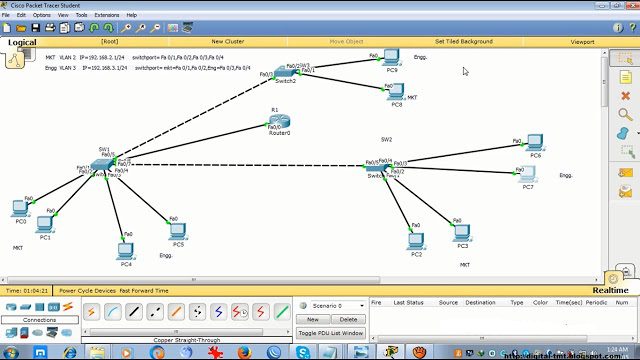Disclaimer
As an affiliate, we may earn a commission from qualifying purchases. We get commissions for purchases made through links on this website from Amazon and other third parties.
Inter VLAN Overview:
Inter VLAN communication comes between broadcast domains via a layer 3 device. In VLAN surroundings, frames are switched simply between ports within the equal broadcast domain. VLAN executes network segmentation and the traffic interval at layer two.
Inter-VLAN routing is a procedure of promotion network traffic from one VLAN to a different VLAN applying a router. Networks are perpetually developing, and in the past, a couple of years an act of courses accepts convert evident.
How does Inter VLAN routing work?
Firstly, the Internet Protocol (IP) has become the Layer 3 communications protocol of alternative for advanced networks, with additional Layer 3 protocols such as Internetwork Packet central (IPX) and AppleTalk speedily beings phased come out. Information processing complects the Internet. The accelerator trust of administrations on the Internet accepts advanced IP as the Layer three protocols of select. Secondly, LANs (local area network) have ascertained fantastic advancements inwards conditions of carrying into action, bandwidth and bringing down costs.
The LAN allows the average all over which users and devices associate to the interior IP electronic network and the Internet thence are an authoritative element of networking. Local area network topologies have acquired from traditionally existence individual, apartment ezines domains into multi-virtual LAN (VLAN) network topology, with inter-VLAN routing asked to enable communications between apiece VLAN.
Binary VLANs increment network efficiency by abbreviating broadcast domain size, as well as providing a mechanism to admit the network layer approach controller to be employed between VLANs. Using multiplex VLANs as well agency that the resilience of the network relies example Layer 2 protocols such as sweeping Tree Protocol (STP), and a lot upon Layer 3 routing protocols. Advanced Layer three routing protocols are a good deal more reasoning than STP and as a consequence could meet a good deal more quickly in the event of a network loser. At last, sectioning a local area network, network into VLANs allows the closing off of troubles to a lower section of the network, provided contracted effect on the network, and easier fault finding.
Configuration part:
Switch1 configuration:
Switch1(config-if)#switchport access vlan 2
Switch1(config-if)#int fa 0/2
Switch1(config-if)#switchport access vlan 2
Switch1(config)#int fa 0/3
Switch1(config-if)#switchport access vlan 3
Switch1(config)#int fa 0/4
Switch1(config-if)#switchport access vlan 3
Switch1(config)#int fa 0/5
Switch1(config-if)#switchport mode trunk
Switch1(config)#int fa 0/6
Switch1(config-if)#switchport mode trunk
Switch1(config)#int fa 0/7
Switch1(config-if)#switchport mode trunk
Switch1(config)#int range fa 0/1 -4
Switch1(config-if-range)#switchport mode access
switch2 configuration:
Switch2>enable
Switch2#configure terminal
Switch2(config)#vlan 2
Switch2(config-vlan)#name MKT
Switch2(config-vlan)#vlan 3
Switch2(config-vlan)#name Engg
Switch2(config)#int range fa 0/1 -2
Switch2(config-if-range)#switchport access vlan 2
Switch2(config-if-range)#switchport mode access
Switch2(config)#int range fa 0/3 -4
Switch2(config-if-range)#switchport acces vlan 3
Switch2(config-if-range)#switchport mode acces
Switch3 configuration:
Switch3>enable
Switch3#configure terminal
Switch3(config)#vlan 2
Switch3(config-vlan)#name MKT
Switch3(config-vlan)#vlan 3
Switch3(config-vlan)#name Engg
Switch3(config)#int fa 0/1
Switch3(config-if)#switchport access vlan 2
Switch3(config)#int fa 0/2
Switch3(config-if)#switchport access vlan 3
Switch3(config)#int range fa 0/1 -2
Switch3(config-if-range)#switchport mode access
Switch1(config)#int fa 0/3
Switch1(config-if)#switchport mode trunk
Router R1: Router configuration:
=====================
Router(config)#int fa 0/0
Router(config-if)#no shutdown
Router(config)#int fa 0/0.1
Router(config-subif)#encapsulation dot1Q 2
Router(config-subif)#ip add 192.168.2.1 255.255.255.0
Router(config)#int fa 0/0.2
Router(config-subif)#encapsulation dot1Q 3
Router(config-subif)#ip add 192.168.3.1 255.255.255.0
you can see video tutorial for better understand:



Leave a Reply
You must be logged in to post a comment.